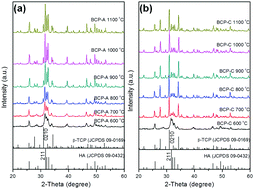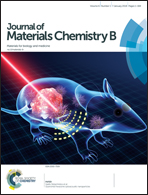Stabilization of Ca-deficient hydroxyapatite in biphasic calcium phosphate ceramics by adding alginate to enhance their biological performances†
Abstract
It is of significance to further improve the bioactivity of existing calcium phosphate (Ca–P) biomaterials to satisfy the needs of regenerative medicine. Due to its compositional similarity to natural bone mineral, calcium-deficient hydroxyapatite (CDHA) is supposed to possess excellent bioactivity. However, it is difficult to fabricate Ca–P ceramics with a high amount of CDHA, as CDHA is easy to decompose during the sintering process. The present study introduced an effective approach to stabilize CDHA in biphasic calcium phosphate (BCP) ceramics by adding alginate, and investigated the roles of CDHA in their biological performances. The characterization of the phase composition, crystal structure, and functional group demonstrated that the addition of alginate could obviously inhibit CDHA decomposition to attain novel BCP ceramics with a high CDHA content (BCP-A), which could better mimic the inorganic composition of natural bones as compared with the conventional BCP ones (BCP-C). In vitro studies suggested BCP-A showed better bioactivity and osteoinductive capacity than BCP-C, as evidenced by the increased serum protein adsorption, better bone-like apatite formation and cell spreading, and promoted osteogenic differentiation. In vivo intramuscular implantation further confirmed that BCP-A could induce more ectopic bone formation than BCP-C, suggesting BCP-A had a stronger osteoinductivity. Altogether, this study demonstrates that the stabilization of CDHA in BCP ceramics by adding alginate offers a promising principle for designing regenerative biomaterials to process superior biological performances.



 Please wait while we load your content...
Please wait while we load your content...